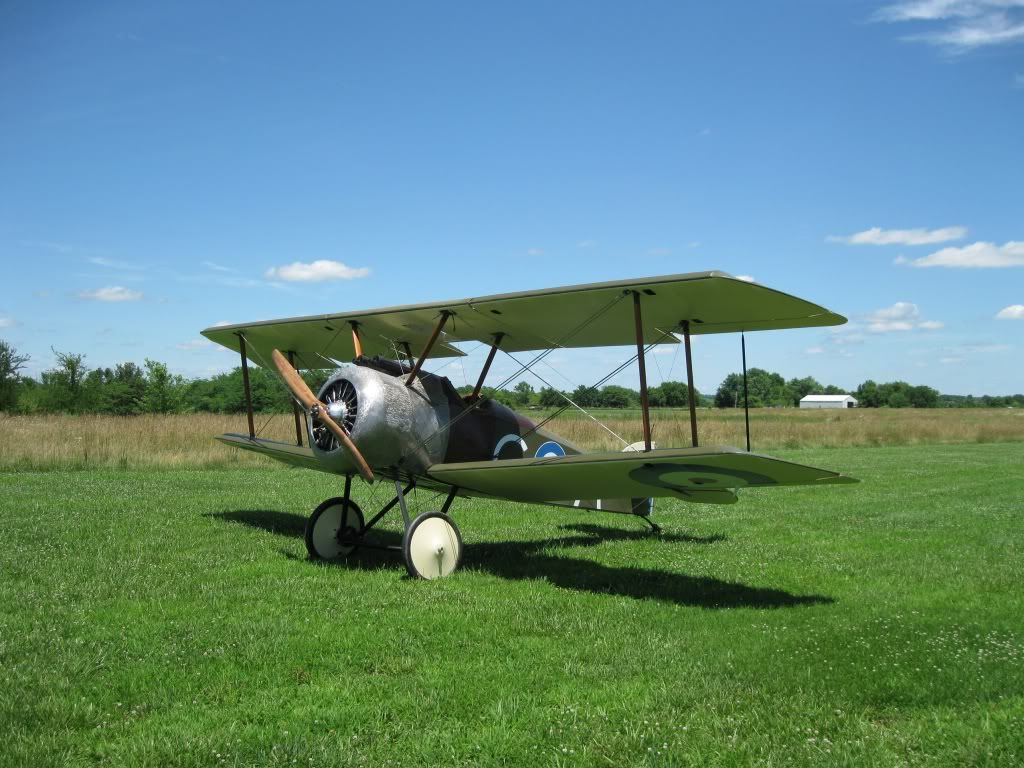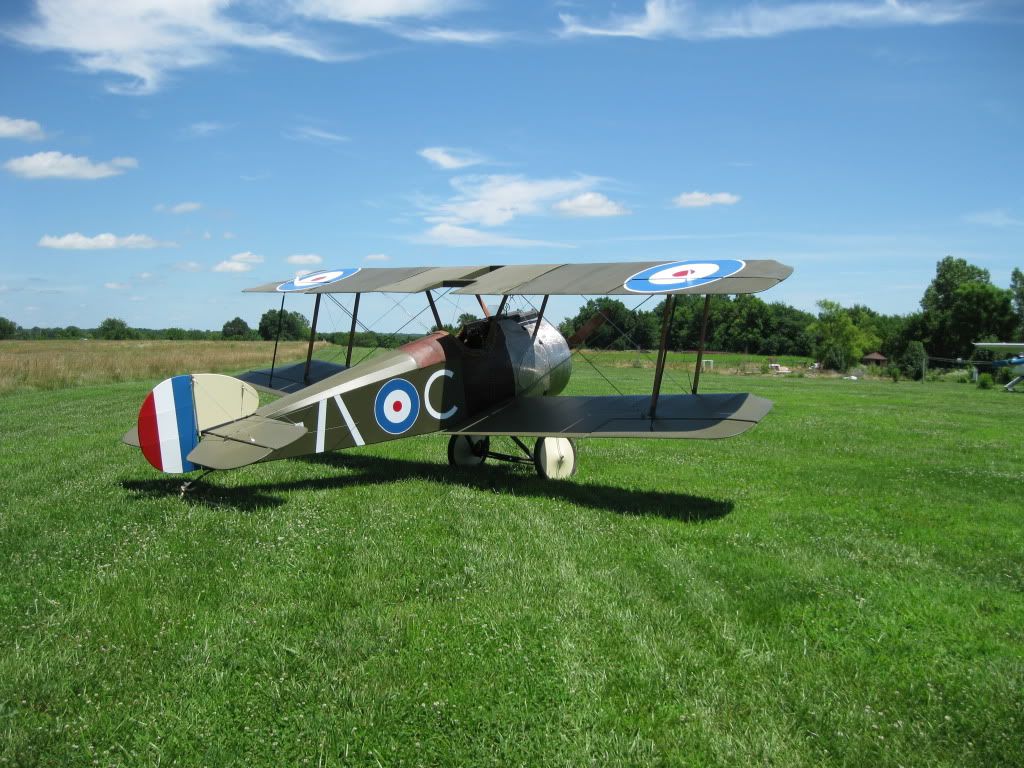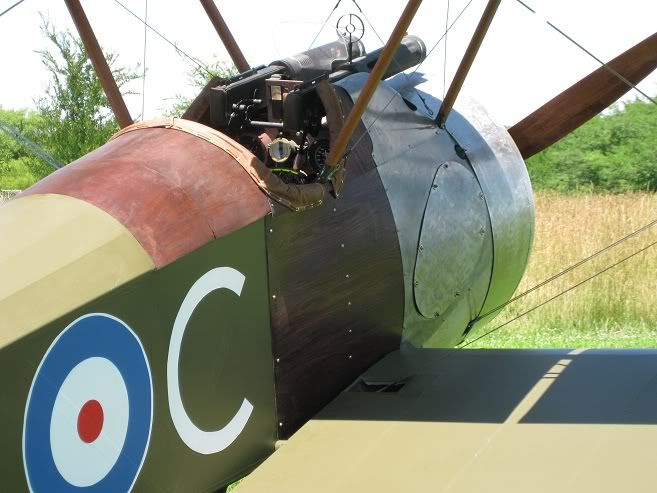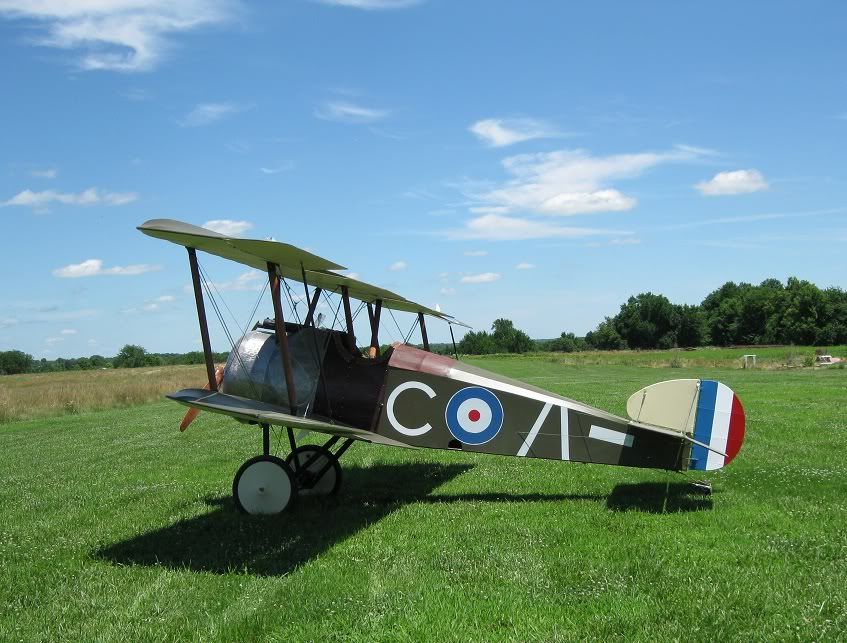Re: Sopwith F.1 Camel Replica project
Mon May 31, 2010 7:47 pm
snj5 wrote:Slow steady progress
Wings painted, Roundels going on
surface control cables done
Yet ANOTHER new throttle linkage to improve directness
will be re-building wood side panels
dual axles mounted
Target - FLY in 2 months, in June/July before OSH
Still wishy washy about a txp to go with the handheld comm
Wonderful project. Would love to see it visit Kingsbury on a workday (every third saturday) or a fly in. "We" are trying to establish a 1900-1939 era venue for enthusiasts. While the museum tends to try to be involved in somewhat original builds, we want to mix in modern tech aircraft such as this. A year ago, the Houston Ne 28 project flew in and was awesome. We fly our DR 1 and Canuck at fly in's (the DVII has a new prop to look pretty but we are still a long way from an engine unless there are new developments), but they need company (the Tommy's are now taking priority-we would like to get one flying in a year and they are now positioned in the shop for work). The idea is to make the field user friendly for historic aircraft up to 1939 but is not limited to those actual designs but also to "tribute" type look alike aircraft of modern build and engines. We have Model T's, 1917 Indian, and now a 1921 Triumph H (which is still basically the Brit WWI design, they didn't mod it much-it would look awesome with your Sopwith for a photo shoot) for photo ops and driving. We want folks like to be a part of pioneerflightmuseum.org on an everyday basis and become leaders in the organization or if they wish, just volunteers or participants. Picture and film opps are just a matter of arranging (the Dr1 does not operate on a moments notice due to everything having to be just right). The Ne 17 in Houston is now a bit on hold I think for a while. A great place to make great friends. We have a new headquarters trailer for PFM now behind the old hangar (still being furnished). Name is Al, ok, I am sort of the cheerleader for Kingsbury. alsumrall2001@yahoo.com We need more San Antonio area pilots actively involved with the facility and with the museum. Right now is a great opportunity for some folks to come in and establish some connections. We have plenty of enthusiasm, but we need some folks to help us keep our aircraft flying and get some more of them in the air (yes that means flying also).
Re: Sopwith F.1 Camel Replica project
Sat Jun 05, 2010 2:13 pm
Hopefully, both Blake in his N28 and I in the little Sopwith bus will be together at the Kbury fall fly-in.
There is another N28 for sale like Blakes on Barnstormers now; Wish we could get a local to bring it home.
There is another N28 for sale like Blakes on Barnstormers now; Wish we could get a local to bring it home.
Re: Sopwith F.1 Camel Replica project
Wed Jun 09, 2010 10:41 pm
I like your philosophy, "safe replica". Could you post some pictures of the wing ribs, spar and rib-spar attachment. Thanks
Bulldog
Bulldog
Re: Sopwith F.1 Camel Replica project
Wed Jun 09, 2010 11:30 pm
snj5 wrote:Hopefully, both Blake in his N28 and I in the little Sopwith bus will be together at the Kbury fall fly-in.
There is another N28 for sale like Blakes on Barnstormers now; Wish we could get a local to bring it home.
The sad thing is that there's no lack of pilots, and I know of one that would definitely be willing to fly something like that, but the economy does seem to be a bit down.
Ryan
Re: Sopwith F.1 Camel Replica project
Wed Jun 09, 2010 11:52 pm
Hoodoo wrote:We need more San Antonio area pilots actively involved with the facility and with the museum. Right now is a great opportunity for some folks to come in and establish some connections. We have plenty of enthusiasm, but we need some folks to help us keep our aircraft flying and get some more of them in the air (yes that means flying also).
Would you shoot me some more details on this?
Ryan
Re: Sopwith F.1 Camel Replica project
Tue Jun 15, 2010 9:49 pm
Bulldog wrote:I like your philosophy, "safe replica". Could you post some pictures of the wing ribs, spar and rib-spar attachment. Thanks
Bulldog
Excellent question
I am travelling now, but the Wings are all aluminum, with aluminum tubular spars and ribs multiple riveted to gusset plates, with a sheet aluminum leading edge. This is Stits fabric covered. Airdrome has built about 50 airplanes with this technique, and has never had a failure. We tested a rivet from each lt and it took over 4000 pounds to separate.
These aircraft are expressly not recommended for aerobatics per the manufacturer (and who can blame him). Blake Thomas, an F-15 pilot who ownes a similarly built N28, states that he has seen 4 Gs in a elevator stick snatch without any problem, but more inportantly, these aircraft (like the originals) have so much immense drag that they cannot sustain any high g loading due to energy and speed bleed off. In a way, that is an interesting "safety feature". The original sharp nosed airfoils are replaced with a more rounded version, softening the stall departure characteristics, but maintaining good flyability for safety for lower time pilots.
Although the flight test data for the Camel is not in, here is the flight test data for Blake's Nieuport, which should be similar. His plane uses a 110 hp Rotec, while the Sopwith, heavier and draggier, uses a 150 hp Rotec.
Airdrome Nieuport 28 with 110 hp Rotec:
Ground Handling Test: This was accomplished on a 3300 foot long, 150 foot wide grass runway. No wind. Without brakes no problems were noted. It took 80 – 100 feet width to make a 180 degree turn with rudder and steerable tail wheel by running the power up opposite aileron input to turn the other direction (right aileron for left turn). The surface winds increased and this made the taxiing more difficult without brakes because the aircraft would weather vane into the wind. With brakes the handling improved, 180 degree turn took 30-40 feet width. The brakes work well for ground operation on modern runways. I believe brakes are a must if you are going to operate on a modern runway or in semi windy conditions. You still have to plan your turns as the airplane cannot make an instant 180 degree turn even with brakes. I only use the brakes for taxiing, not takeoff or landings.
Flight Test:
Takeoff: The Rotec R2800 engine worked well. On the initial takeoff, I allowed the aircraft to accelerate to 60 MPH and rotated at 800 feet down the runway. Climb speed was 55-60 MPH with 600-800 FPM climb. Rudder and ailerons were very responsive. When the winds became gusty, it was better to climb at 65-70 MPH at 400-600 FPM as the controls were more responsive to counter the wind gusts at low altitude. The strongest winds I’ve flown in were down the runway at 16 gusting to 33 KTS. I would not recommend flying in these conditions, it was absolutely miserable with turbulent 2 G forces in the bumps. And, without brakes it would have been impossible to taxi safely. So far, the maximum X-wind takeoff is 10-12 MPH. I believe any more than that and you will run out of rudder. I do not use brakes on takeoff for directional control.
Climbs: Climbs were accomplished at many speeds. The best seemed to be 55-60 MPH. Any faster or slower would substantially cut climb rate. Elevator trim worked well.
Max Altitude: Max altitude so far is 10,000 feet which I reached in 30 min. I recommend you take oxygen above 10,000 feet. Indicated speed at 10,000 feet was 57-62 MPH. Take a jacket/long underwear—it is cold up there even with a heater in the aircraft.
Turns: Turns were responsive with coordinated ailerons and rudder inputs. This is the most difficult input to make because the ailerons feel normal, but the rudder drifts on you in a turn and becomes more difficult to control the more rapid your aileron input is (keep the ball centered). The rudder wants to skid or slip on you so you have to dance on the rudder in your turns.
Cruise Speeds: Cruise Speeds with 3100 RPM Max is 87-90 MPH, 3000RPM is 85-87 MPH, 2800RPM is 80-82 MPH, 2700 RM is 70-75 MPH, 2600 RPM is 60-65 MPH. The elevator trim is a must. It allows you not to have to hold stick pressure in cruise flight. It also allows you to let go of the stick to accomplish other things in the cockpit. It is a poor man’s autopilot. Also works good in climbs and descents.
Descent: Descents are normal reduced RPM and adjust elevator trim to maintain 80-85 MPH, if it gets bumpy, 70-75 MPH works better. The faster you want to descend, just pull more power and the faster you come down. Again, elevator trim is wonderful.
Landings: Landings are really nice when wheel landed. I used my visual takeoff attitude as a reference for my landings. A full stall, 3-point landing is difficult because you cannot see out in front of you. Recommend only wheel landings with a normal final approach of 60-65 MPH or if winds are gusty, 65-70 MPH. Touch down speeds vary 48-52 MPH. Roll out distances vary between 800 to 1700 Ft. On roll out after landing, when I am slowed to a taxi speed I use brakes if required for taxiing.
Stalls: Stalls just like a Champ/Cub/Luscombe. Straight forward and does not fall off on a wing as long as your rudder inputs are good and smooth; power on or off. Stall speed power on is 38 MPH and power off is 42 MPH. To recover out of a power on stall, just release a little back pressure. To recover from a power off stall, just add power and the additional airflow over the tail allows the aircraft to recover almost instantly.
Re: Sopwith F.1 Camel Replica project
Tue Jun 15, 2010 10:28 pm
Sounds like fun. Hope your plane flies as nice or better!
Ryan
Ryan
Re: Sopwith F.1 Camel Replica project
Sat Jun 26, 2010 7:31 pm
Rollout.
Now comes rigging details and FAA inspection prep.
Airdrome Aeroplanes and I started this plane 6 mos ago and it costs about as much as a good sized SUV.
www.airdromeaeroplanes.com

Now comes rigging details and FAA inspection prep.
Airdrome Aeroplanes and I started this plane 6 mos ago and it costs about as much as a good sized SUV.
www.airdromeaeroplanes.com

Re: Sopwith F.1 Camel Replica project
Mon Jun 28, 2010 10:31 pm
A couple more.
Have decided to go 'au natural' with no permanently mounted avionics or lights, keeping original instruments.


Have decided to go 'au natural' with no permanently mounted avionics or lights, keeping original instruments.


Re: Sopwith F.1 Camel Replica project
Mon Jun 28, 2010 10:36 pm
You ready for the challenge of test-flying it?
Ryan
Ryan
Re: Sopwith F.1 Camel Replica project
Wed Jun 30, 2010 5:13 pm
RyanShort1 wrote:You ready for the challenge of test-flying it?
Ryan
No
Am having a professional test flyer test fly it. He knows what to look for.
Re: Sopwith F.1 Camel Replica project
Thu Jul 01, 2010 7:26 am
Of course, one must dress appropriately


Re: Sopwith F.1 Camel Replica project
Fri Jul 02, 2010 10:12 am
FAA airworthiness inspection scheduled for the 9th of July.
Assembling package to send off to the DAR on Monday:
Program Letter
FAA Form 8130-6 aplication for Airworthiness Certificate,
Notarized FAA Form 8130-12 Eligibility Statement,
Three view drawing or photos, and
Weight and balance form showing most forward and aft center of gravity positions are within established limits.
Am feverishly sifting through hundreds of photos to assemble the build log. Should have been doing this all along with narrative.
Once Airworthiness certificate issued, then hope to fly the following week.
For all my fellow larger guys thinking about a WW1 replica, I am a a 6'2" 260 pound guy in the cockpit - quite comfortable as well. I've "tried on" numerous replica Allied WW1 planes: the Camel and, oddly enough, the Nieuport 17 (I sat in one of the "Flyboys" movie flying N17s, a 90 - 100 mph plane and quite cool. I know where one is for sale if you are interested) were the roomiest. I am told the Dr.1 is also quite spacious, but I have not been in one.
Assembling package to send off to the DAR on Monday:
Program Letter
FAA Form 8130-6 aplication for Airworthiness Certificate,
Notarized FAA Form 8130-12 Eligibility Statement,
Three view drawing or photos, and
Weight and balance form showing most forward and aft center of gravity positions are within established limits.
Am feverishly sifting through hundreds of photos to assemble the build log. Should have been doing this all along with narrative.
Once Airworthiness certificate issued, then hope to fly the following week.
For all my fellow larger guys thinking about a WW1 replica, I am a a 6'2" 260 pound guy in the cockpit - quite comfortable as well. I've "tried on" numerous replica Allied WW1 planes: the Camel and, oddly enough, the Nieuport 17 (I sat in one of the "Flyboys" movie flying N17s, a 90 - 100 mph plane and quite cool. I know where one is for sale if you are interested) were the roomiest. I am told the Dr.1 is also quite spacious, but I have not been in one.
Re: Sopwith F.1 Camel Replica project
Fri Jul 02, 2010 8:11 pm
Couple of more photos.
I am 6'2" and 250# and this is a comfortable plane. Not all WW1 planes are for folks like me...


I am 6'2" and 250# and this is a comfortable plane. Not all WW1 planes are for folks like me...


Re: Sopwith F.1 Camel Replica project
Fri Jul 02, 2010 10:33 pm
Too cool! Wish I had something intelligent to say, but mostly I just want email alerts to new posts to this thread. 
I hope to lay eyes on her for real soon .... somewhere .... somehow. In the meantime, keep those pictures coming!
I hope to lay eyes on her for real soon .... somewhere .... somehow. In the meantime, keep those pictures coming!